People
Daniel Shays
1747-1825
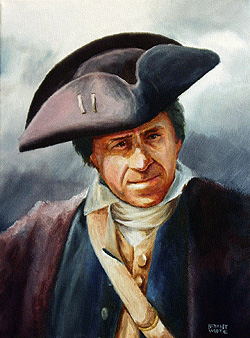
Daniel Shays
© 2008 Bryant White
Prologue
Daniel Shays' parents emigrated from Ireland to the Massachusetts Bay Colony in the 1730s. Patrick and Margaret (Dempsey) Shays married in 1744 and set up housekeeping in Hopkinton, Massachusetts. In 1747, Margaret gave birth to Daniel, the second of what would be a family of six children. (1)
Little is known of Daniel's early life, but a few fragments of surviving information are suggestive in light of his later career and reputation. We know that, in common with other young men without land of their own, Daniel Shays hired himself out to work. According to a contemporary, by the early 1770s, Shays was living on a farm in Brookfield, where he was paid above the going rate for a laborer in recognition of his performance as a "smart, active" man. The same resident recalled that the young Daniel Shays "had much taste for the military." When young men assembled for militia training days, some armed only with wooden guns and swords, Shays enthusiastically drilled them. (2)
Hard worker or not, men like Daniel Shays without a trade or land to farm, generally delayed marriage until their mid-twenties. At the age of 25, Daniel Shays appeared in the town records in 1772 with Abigail Gilbert when the couple published their intention to wed. Their first child, Daniel junior, was born in 1773. Other children followed, including two daughters. It is not known how many children were born to Daniel and Abigail, although an elderly Daniel Shays would refer to the difficulty of maintaining a "large and Expensive family." (3)
As war with England seemed ever more likely, the old militia exercises assumed a more serious character. Daniel seems never to have faltered in his commitment to the American Whig, or Patriot, cause. He did not remain a member of the Brookfield militia, however. At some point between 1774 and 1775, Daniel and Abigail moved west to Shutesbury, where Shays joined militia from Shutesbury, Amherst and Leverett. His experience in drilling may explain why he appeared on the company roll as Sergeant Daniel Shays. When Captain Reuben Dickinson's company marched to Cambridge in 1775 following the fighting at Lexington and Concord, Shays received 18 shillings, 10 pence for 11 days of service. (4)
An Officer and a Gentleman
Sergeant Shays soon became Lieutenant Shays. He fought at Bunker Hill and at Ticonderoga. By 1777, Shays had leveraged his ability to raise men willing to serve under him into a Captain's commission in the Fifth Massachusetts Regiment of the Continental Army. His commission was not official until 1779, but it was backdated to January, 1777. In the meantime, Captain Shays continued to build his reputation as a courageous and competent officer, including fighting Burgoyne's invading army at Saratoga, New York, and participating in the desperate action at Stony Point, New York. General Lafayette himself honored Captain Shays along with other officers under his command with a ceremonial sword as a mark of his personal esteem. (5)
Though he came from a poor background, Shays tried hard to maintain the demeanor and engage in the activities expected of a commissioned officer. Like many of his fellow officers, he was a Mason, having joined a lodge in New York in 1778 during his service there. (6) In common with many Continental Army officers, Shays struggled to make ends meet. With his pay in constant arrears and no sign of relief in sight, Captain Shays decided to part with the sword General Lafayette had bestowed on him. Shays' decision to sell the sword unleashed a firestorm of criticism from his fellow officers and contributed to his decision to resign his commission in 1780. (7)
By the end of the war, Daniel Shays was living in Pelham with Abigail, where his military rank and distinguished service earned him the respect of his fellow residents. Populated primarily by poor Scots-Irish residents, the rocky soil and hills of Pelham made farming difficult. Most farmed fewer than 25 improved, or cleared, acres. The town probably attracted Daniel Shays for that very reason. Rocky acres in Pelham were more affordable than the rich bottom lands in Connecticut River Valley towns like Northampton and Hadley. The Shays family at one point owned as much as 251 acres, but financial difficulties in the severe post-war recession forced Daniel to sell over half his land. By 1785, Shays was having difficulty meeting his obligations. He would be sued at least twice for unpaid debts in 1786. (8)
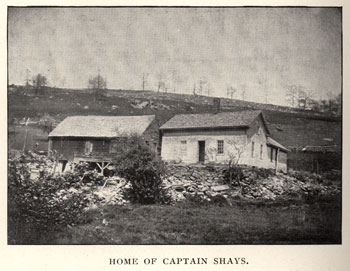
Daniel Shays' home in Pelham. The house was destroyed and the surrounding lands flooded during the creation of the Quabbin Reservoir in the 1930s.
More info
Courtesy Pocumtuck Valley Memorial Association, Deerfield, MA
Captain Shays was not the only Massachusetts resident suffering financial hardship during the recession that had followed a brief post-war boom. The determined attempt by the Massachusetts Legislature to pay off the state's war debt through an aggressive taxation policy despite the hard times proved disastrous. The government's insistence that people pay their taxes in hard money rather than in goods or paper currency made a bad situation worse. The little gold and silver in circulation was not in the hands of farmers, whose assets were tied up in land, livestock and produce. Pelham joined dozens of towns across the Commonwealth in petitioning for debtor relief, and for laws lowering judicial court fees and government salaries. (9)
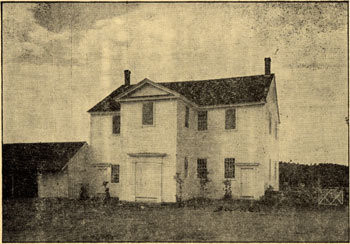
Daniel Shays and other Pelham residents met here to discuss grievances and petition the Massachusetts General Court. The Pelham Town Hall is the oldest town hall in continuous use in the United States.
More info
ourtesy Pocumtuck Valley Memorial Association, Deerfield, MA
The government chose not to enact the debtor relief and reforms for which the petitioners pleaded. Instead, the General Court urged Massachusetts citizens to exercise patience and frugality. (10) When the government proved unresponsive to the blizzard of town petitions and resolutions from county conventions, thousands of men marched on the Massachusetts courts. As in the years leading up to the Revolution, armed men prevented courts from convening or conducting any business. They called themselves Regulators and insisted they were there to uphold justice.
It was at this point that Daniel Shays emerged as one of the local leaders of the protest movement. Shays met with other local men at Conkey's Tavern in Pelham, where they discussed their situation and what could be done in the face of the government's lack of interest in constitutional reforms or debtor relief policies.
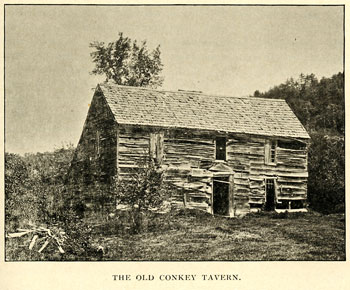
Conkey's Tavern in Pelham was a popular gathering place for Daniel Shays and other local Regulators.
More info
ourtesy Pocumtuck Valley Memorial Association, Deerfield, MA
A Reluctant Leader
Shays was, by all accounts, a reluctant leader. He had refused to lead the Pelham contingent when the Regulators marched on the Northampton Court of Common Pleas in August, 1786. Yet, the following month, he played a prominent role in an even more dangerous protest. Everyone expected that the judges of the Supreme Judicial Court session scheduled to sit at Springfield in September would issue indictments against Captain Luke Day of West Springfield and other men who had led the Regulators against the Northampton court. Captain Shays agreed to present the demands of the Regulators that the Springfield court not issue any indictments or sit again until the grievances of the people had been addressed. Tensions ran high, but Shays believed he could keep the situation from getting out of hand by assuming leadership over the angry and potentially violent group of protesters, many of whom had made a point of coming armed with muskets and clubs. (11)
Captain Shays cut an impressive figure in his Continental Army uniform. His dignified air of command and his confident knowledge of military protocols lent credence and respectability to the ranks marching on the courthouse. He rode forward to confer with General William Shepard, commander of the militia troops stationed in front of the court house. The two former Continental Army officers negotiated the peaceable abandonment of the courthouse by the judges and the militia. In return, Shays agreed that the Regulator troops would confine themselves to peaceably marching and demonstrating in front of the building rather than seeking to close it by force. (12)
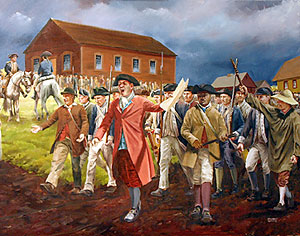
Captain Daniel Shays presented the demands of the Regulators and negotiated the peaceful abandonment of the courthouse with the commander of the government militia General William Shepard. Detail from Petition and Protest
© 2008 Bryant White
Shays' appearance at the head of the Regulators at Springfield marked a turning point for him personally and for the Regulator movement in general. For the first time, the Regulators had closed not only the lower Court of Common Pleas, but a session of the Supreme Judicial Court. The Massachusetts General Court interpreted the closing of the Commonwealth's highest court as a direct assault on the sovereignty of the state government. Almost overnight, Shays rose to the top of the government's most wanted list and was labeled the "generalissimo" of the movement the Friends of Government were calling a rebellion. Although Shays did not know it, the momentum had begun to build that would result in his name becoming synonymous with the Regulation. (13)
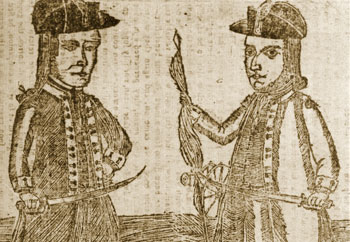
This 1787 woodcut depicts the two men the government believed were the leaders of the Regulator movement: Daniel Shays of Pelham and Job Shattuck of Groton.
More info
Courtesy National Portrait Gallery, Smithsonian Institution, Washington, DC
As for Shays himself, the Springfield court closing offered an opportunity to observe the strengths and the weaknesses of the Regulator movement. The men he led were eager to protect the rights for which many of them had fought in the recent war. At the same time, Shays saw that many of the men were unarmed and poorly equipped. Unlike General Shepard's government militia, the Regulators had not had access to the weapons and stores of the United States Arsenal at Springfield. The government militia had even commandeered a cannon from the Arsenal and placed it in front of the courthouse. Although his men scoffed at the cannon they called the "government's puppy," Shays knew that the lack of weapons would prove a serious weakness in any armed confrontation with the government militia. (14)
The militia and the Regulators agreed to "go home friendly" following the closing of the Springfield Supreme Judicial Court, but ugly confrontations at courthouses across the state continued throughout the fall and winter. (15) The government decided to take control of the situation by capturing Job Shattuck of Groton, a prominent local man believed to be a ringleader and primary instigator of the armed protests. When a group of mounted militia from Boston cornered and seriously wounded Shattuck, Shays and other Regulators had had enough. Rumors of atrocities inflicted by the troops on innocent bystanders, including women and children, alarmed and inflamed the Regulators. By December, Shays and a committee of 17 were writing circulating letters to towns "in the present movement of the people" throughout Hampshire County, urging them to raise militia companies to meet regimental quotas to stand against the government. (16)
The state legislature was not idle; it threatened alarming consequences for Regulators, while at the same time offering pardons to any who took an oath of allegiance and laid down their arms. Private subscribers came forward to fund the raising of an emergency state militia "for the purpose of quelling the Tumults & securing the Rights of the Citizens." (17)
An Unwilling "accessary to the shedding of blood"
Shays was in a difficult situation. He saw himself as a mediator; he had worked hard to keep the confrontation at the September court closing from escalating into violence. Yet, it was becoming ever clearer that the government considered him one of the leaders and an incorrigible rebel. His options for a peaceful mediation that involved a pardon for himself were rapidly diminishing. In a letter to Governor Bowdoin, General Rufus Putnam reported that Shays emphatically denied any leadership role in the Regulation. According to Putnam, Shays described his role in Springfield in September as that of a peacemaker determined to avert bloodshed, and claimed that he had only reluctantly gone along with subsequent court closings. When Putnam asked him, "had you an opportunity would you accept of a pardon and have those people to themselves?" Shays replied, "Yes—in a moment." (18)
Thrust into a role he had not sought, Shays continued to work for a peaceful resolution. In a January communication to General Shepard, Shays insisted that he was "unwilling to be any way accessary to the shedding of blood, and greatly desirous of restoring peace and harmony to this convulsed Commonwealth." At the same time, he tried to strengthen the negotiating position of the Regulators by improving their situation. The men were poorly armed and equipped; Shays knew there were arms and supplies at the Springfield Arsenal. The Arsenal barracks also offered welcome shelter from the bitter winter weather. Shays and the other local Regulator leaders agreed that they would rendezvous and march on the Arsenal on January 25. Captain Luke Day of West Springfield would bring a regiment, Captain Eli Parsons would bring men down from Chicopee, and Daniel Shays himself would come with a regiment west from Palmer, through Ludlow and Wilbraham. All three groups together numbered about 1,800 men. (19)
Unfortunately for Shays, the government militia was already occupying the United States Arsenal. General Shepard had worried for months about the vulnerable situation of the Arsenal. He lacked authority to commandeer the arsenal stores since they were the property not of the state of Massachusetts, but of the United States government. Shepard feared that, should the Regulators obtain the Arsenal stores, they would be better armed than the government militia he commanded, or the army making its way west from Boston under General Benjamin Lincoln. He decided upon the risky course of occupying the Arsenal grounds and commandeering its stores. The Regulators would have to take the Arsenal by force if they could not convince Shepard and his militia to peaceably abandon it as they had the courthouse four months earlier. (20)
For reasons that remain unclear, Captain Day chose not to cross the Connecticut River to join Captains Parsons and Shays in their advance. Instead, he stayed where he was, and issued an ultimatum demanding that General Shepard's men relinquish their weapons and abandon the Arsenal. (21)
Day's message that he did not expect to come to action on January 25th was intercepted before it reached Shays. As the column of about 1,200–1,400 Regulators under Shays and Parsons approached, Shepard sent officers to meet with Shays and warn him away from the Arsenal. Shays responded by expressing his determination to take the Arsenal stores and barracks. Despite warnings that he would encounter deadly force if he insisted on advancing, Shays ordered the column to continue, and rode to the rear to bring up the rest of the men with more speed.
It is not clear whether Shays or his men believed the government militia defending the Arsenal would in fact fire on them. Men from Colrain and Greenfield manned the Arsenal artillery. Would they shoot at members of their own and neighboring communities? What is clear is that the Regulators disregarded warning shots fired over their heads and continued to advance through the snow in columns, eight abreast. When Shepard ordered the artillery to open fire in earnest, the center of the Regulator column dissolved into chaos, and the veterans in the advance had no choice but to flee themselves. (22)
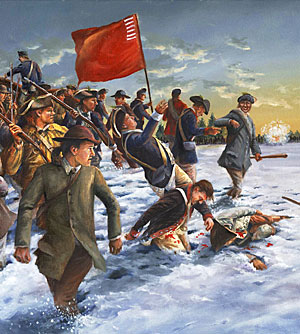
The Regulator advance turned into a retreat as round after round of artillery slammed into the center of the advancing Regulator column. Detail from Bloody Encounter - Regulators
© 2008 Bryant White
Whatever Shays had expected, he was not prepared for the pell-mell retreat of the entire column. Many men fled to their homes or went into hiding. Those who re-formed into a coherent group raced for the relative safety of Chicopee, where Shays sent a message to Shepard asking that he be allowed to retrieve his dead and wounded under a flag of truce. Then it was on to South Hadley, and from there a weary, cold march to Pelham where what was left of the Regulator column encamped. (23)
Letters and communications went back and forth from Captain Shays to General Benjamin Lincoln, who had arrived in Springfield two days after the Arsenal action. Losing no time, Lincoln crossed the frozen Connecticut in a combined action with Shepard's militia and routed Captain Day's regiment. Now he was preparing to pursue Shays and the men remaining under his command. Shays and his officers insisted that their cause was just, and that pardons for officers as well as regular men-at-arms would help defuse the situation. Instead of promising pardons, Lincoln planned his pursuit. When he received news that the Regulators had slipped away from Pelham, Lincoln provisioned his men for three days and sent them on a 30-mile march from their camp at Hadley to intercept and attack the Regulators at Petersham. Lincoln did not know that he was sending his men into a brutal nor'easter that began in the middle of the night. When the advance staggered into Petersham on the morning of February 3, they caught their quarry by complete surprise. This last reversal demoralized the remaining Regulators; Shays sent out the word that it was every man for himself, and with his officers, slipped over the border into New Hampshire. (24)
Dangerous and Tedious Ordeal
Now began a long, dangerous and tedious ordeal for Daniel Shays. Through the winter and spring of 1787, Shays would have heard news of the men who had been captured, arrested and condemned to death. Fearful of capture and knowing he had been indicted on charges of high treason, he moved from place to place, never staying longer than one or two days in one location. From New Hampshire, he went to Vermont. Abigail joined him there, where she, too, lived a life on the run, afraid to confide in anyone lest her husband be recognized and arrested. (25)
Hope must have stirred in Daniel Shays as he learned that virtually all of the Regulators, including those the government had identified as leaders and sentenced to death, had been pardoned and released. The newly-elected John Hancock signaled a more lenient and benign administration. The Massachusetts government and people alike seemed eager to put the turmoil of the previous year behind them. Attention now focused not on the Regulators, but on the debates over the proposed Constitution created at Philadelphia in the summer of 1787.
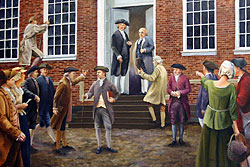
The unrest in Massachusetts added urgency to the mission of the Philadelphia Convention, where delegates from 12 states gathered "to ensure domestic tranquility." Detail from Making a Nation
© 2008 Bryant White
A similar desire for stability, conciliation and consensus characterized the Massachusetts ratifying convention, which included a number of former Regulators and sympathizers. Many of the 168 delegates who voted against the decision to ratify the federal Constitution made a point of expressing their willingness to accept the decision of the Convention. A month later, on March 10, 1788, Daniel Shays and Eli Parsons petitioned the Massachusetts Legislature for clemency. In April, Governor John Hancock canceled the rewards still being offered for their capture. Finally, on June 25, both men received a full pardon. (26)
Epilogue
Daniel Shays returned to Pelham after he received his pardon, but he did not remain there long. In an attempt to improve his gloomy economic fortunes, he moved to New York in 1795, and settled in the town of Rensselaerville in Albany County, New York. He then moved to Livingstonville, but by 1805 he had sold his land and moved on. He eventually settled in Sparta, New York (now Conesus) with a daughter and son-in-law. He was a widower now, although it is not known when or where Abigail Shays died. In 1815, Daniel Shays married Rhoda Havens, an innkeeper and widow. Three years later, at age 77, Shays submitted a petition to Congress under a pension act awarding assistance to indigent veterans who had served in the Continental Army during the American Revolution. His petition documented his service record and declared that "during the whole Time of his Service, he conducted with Fidelity, and Reputation and attended to his Duty with the greatest Circumspection and Dilligence." Citing a severe wound he received in 1775 that had made him permanently "unable to labour," and a "large and Expensive Family dependent on his Care and Support," he asked Congress for either the five years officer's pay he had never received, or to be placed on the pension list. The government granted his petition for a pension, and Shays used it to buy 12 acres of land where he built a house and barn. Daniel Shays died in obscurity in Sparta on September 23, 1825, at the age of 78.
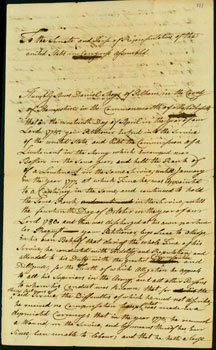
Daniel Shays filed this request for a Continental Army pension in 1818.
More info
Courtesy, Forbes Library, Special Collections, Northampton, MA
Scant biographical information and his own self-professed ambivalence have combined to create a complex legacy for Daniel Shays. In 19th century histories celebrating the creation of the Constitution, Shays was cast as the "misguided" leader of a "hapless rebellion against authority." A monument erected in 1927 in Petersham followed suit, celebrating the rout of Daniel Shays and his followers, who were "in rebellion against the Commonwealth" and sternly concluding that "Obedience to Law is True Liberty."
Among some Americans, however, Daniel Shays was becoming something of a folk hero. A clue into this rehabilitated image of Shays and the movement that bears his name appeared in Leslies' Weekly Illustrated Paper in 1900 with the claim that "The first of America's Populists was Daniel Shays." It is no surprise that in an era in which farming and urban interests seemed irreconcilably opposed, that populists cast Daniel Shays as an agrarian hero who sought to reform a system hostile to struggling farmers. (27)
Daniel Shays continued to attract renewed interest and admiration into the 20th century. In 1931 Walter Dyer wrote Sprigs of Hemlock , which Arthur M. Schlesinger, Jr., reviewed approvingly in the New England Quarterly as "a very readable book for boys" that drew a "very different picture of Daniel Shays from that which is usually given by historians." Similarly, James and Christopher Collier's 1978 novel The Winter Hero offered younger readers a more nuanced, sympathetic reading of Daniel Shays and his fellow Regulators. (28)
A new monument erected in Petersham in 1987, offered what is becoming a more popular interpretation of Daniel Shays and the Regulators:
In this town on Sunday morning, February fourth, 1787, CAPTAIN DANIEL SHAYS and 150 of his followers who fought for the common people against the established powers and who tried to make real the vision of justice and equality embodied in our revolutionary declaration of independence, was surprised and routed, while enjoying the hospitality of Petersham, by General Benjamin Lincoln and an army financed by the wealthy merchants of Boston.
True Liberty and Justice may require resistance to law.
Daniel Shays has been memorialized locally in a variety of ways. In Pelham there is a monument to the Regulators and their cause. Nearby Amherst has "Shays Street" and the Horse Caves, an overhanging ledge under which, according to local legend, Daniel Shays hid during the Regulation. (29) Route 202, part of which runs through Pelham and nearby towns, is "Daniel Shays Highway." There is a Boston-based rock band called "Shays' Rebellion," and an internet provider for Western Massachusetts known as "Shaysnet." The Northampton Brewery in Northampton, MA, sells "Daniel Shays' Best Bitter."
It remains to be seen how future Americans will view Daniel Shays and the movement that, accurately or not, bears his name. What does seem clear is that however little we know of him personally, Daniel Shays will continue to excite the interest of those who admire, and those who disagree with, the choices he made.
The Ballad of Daniel Shays
My name is Shays, in former days,
In Pelham I did dwell, sir,
But now I'm forced to leave that place,
Because I did rebel, sir.
Within the state, I lived of late,
By Satan's foul invention.
In Pluto's cause, against the laws
I raised an insurrection.
'Twas planned below, by that arch foe,
All laws should fall before me;
Though in disgrace, the populace
Did, Persian like, adore me.
On mounted steed I did proceed
The Federal stores to plunder;
But there I met with a bold salute,
From Shepard's warlike thunder.
he kindly sent his aid-de-camp
To warn me of my treason;
But when I did his favors scorn,
He sent his weighty reason,
Then Shays returned to Vermont state,
Chagrined and much ashamed, sir;
And soon the mighty rebel host,
Unto the laws were tamed, sir.
Oh, then our honored fathers sat,
With a bold resolution,
And framed a plan and sent to us
Of noble constitution.
America, let us rejoice
In our new constitution.
And never more pretend to think
Of another revolution. (30)
About This Narrative
Note: All narratives about people are, to the extent possible, based on primary and secondary historical sources.
See Further Reading for a list of sources used in creating this narrative. For a discussion of issues related to telling people's stories on the site, see: Bringing History to Life: The People of Shays' Rebellion
| Print | Top of Page